Ever felt like decoding the secrets of the universe, one hash at a time? The allure of cryptocurrency mining, particularly with powerful GPU rigs, draws in digital prospectors dreaming of striking digital gold. But beneath the shimmering surface of potential riches lies a complex landscape of hardware, algorithms, and cold, hard electricity costs. Let’s dive in, shall we, and separate the signal from the noise. Think of it as a treasure map, but instead of buried doubloons, we’re chasing satoshis.
The GPU Advantage: Horsepower Unleashed. Unlike CPUs, GPUs, originally designed for rendering graphics, possess a massively parallel architecture. This means they can perform a vast number of calculations simultaneously, crucial for the intensive computations required by many proof-of-work cryptocurrencies. Think of it as having hundreds of tiny workers digging for gold instead of just one. While ASICs (Application-Specific Integrated Circuits) are even more specialized and efficient for specific algorithms (like Bitcoin’s SHA-256), GPUs offer versatility, capable of mining a wider range of cryptocurrencies like Ethereum (though post-Merge, this is less relevant), Monero, and Ravencoin.

Case Study: Ravencoin Renaissance. Post-Ethereum Merge, many miners sought new pastures. Ravencoin, using the KawPow algorithm, experienced a significant surge in mining activity. Miners repurposed their Ethereum mining rigs, reconfiguring them for Ravencoin. This highlights the adaptability of GPU mining. According to a 2025 report by Cambridge Centre for Alternative Finance, GPU-mined cryptocurrencies are increasingly seen as a hedge against ASIC dominance in the proof-of-work space.
The Electricity Elephant in the Room. Mining ain’t free, partner. All that computational horsepower sucks power, and power costs money. Factoring in electricity costs is paramount. What “the big boys” don’t want you to know is that the profitability of GPU mining hinges heavily on your electricity rate. A high rate can quickly eat into your profits. Location, location, location. Choosing a location with cheap electricity is crucial. Consider regions with renewable energy sources for both cost savings and environmental responsibility.
Mining Rig Rundown: Picking Your Poison (Er, Card). Not all GPUs are created equal. AMD and Nvidia dominate the market, and each offers cards with varying hash rates (the speed at which they solve cryptographic problems) and power consumption. Research is key. Read reviews, compare benchmarks, and choose cards that offer the best hash rate per watt ratio. Pro-tip: Look for used cards. You can often snag a bargain, but be sure to test them thoroughly before committing.
Theory Meets Reality: Building Your Rig. Building a GPU mining rig involves more than just plugging in graphics cards. You’ll need a suitable motherboard, power supply, cooling system, and a stable internet connection. Overclocking (pushing the cards beyond their factory settings) can boost performance, but it also increases power consumption and heat. Tread carefully and monitor temperatures diligently. Remember, heat is the enemy.
The Software Side: Miners and Pools. Once your rig is built, you’ll need mining software. Popular options include CGMiner, BFGMiner, and Claymore’s Dual Ethereum Miner (though Ethereum is no longer mineable). You can mine solo, but joining a mining pool increases your chances of receiving regular payouts. Mining pools combine the computational power of many miners, allowing them to solve blocks more frequently. Choose a reputable pool with low fees and reliable uptime.
DOGE Dreams and ETH Echoes: Mining Alternatives. While Bitcoin remains the king, GPU mining primarily focuses on altcoins like Dogecoin (via merged mining with Litecoin), Ethereum Classic, and others. The profitability of each coin fluctuates based on its price, network difficulty, and block reward. Stay informed about market trends and network developments to optimize your mining strategy. According to a recent Delphi Digital report, the rise of layer-2 scaling solutions for Ethereum could lead to a resurgence in GPU mining for other cryptocurrencies as miners seek new avenues for profitability.
Mining Farms and Hosting: Scaling Up (or Out). For those with deeper pockets, mining farms offer economies of scale. However, setting up and managing a large-scale operation requires significant expertise and capital. Alternatively, mining machine hosting services provide a turnkey solution. You purchase the hardware, and they handle the infrastructure, maintenance, and electricity. This can be a viable option for those who want to participate in mining without the hassle of managing their own rig.
Regulatory Rumbles: The Shifting Sands. The regulatory landscape for cryptocurrency mining is constantly evolving. Some jurisdictions have imposed restrictions or outright bans on mining due to environmental concerns or energy consumption. Stay informed about the legal and regulatory environment in your region to ensure compliance. This is not financial advice, by the way – consult with legal professionals before making any decisions.
Is GPU Mining Still Worth It? The answer, as always, is “it depends.” Profitability is affected by numerous factors, including cryptocurrency prices, network difficulty, electricity costs, hardware costs, and regulatory changes. Do your research, crunch the numbers, and understand the risks before diving in. Remember, mining is a marathon, not a sprint. The goal is to stack sats consistently over time, not to get rich quick.
Dr. Anya Sharma
is a leading expert in blockchain technology and cryptocurrency mining.
She holds a PhD in Computer Science from Stanford University and is a Certified Bitcoin Professional (CBP).
Dr. Sharma has published extensively in peer-reviewed journals and is a sought-after speaker at industry conferences. Her research focuses on the optimization of mining algorithms and the environmental impact of cryptocurrency mining.
She also serves as an advisor to several blockchain startups and is a strong advocate for responsible and sustainable cryptocurrency mining practices.
Leave a Reply